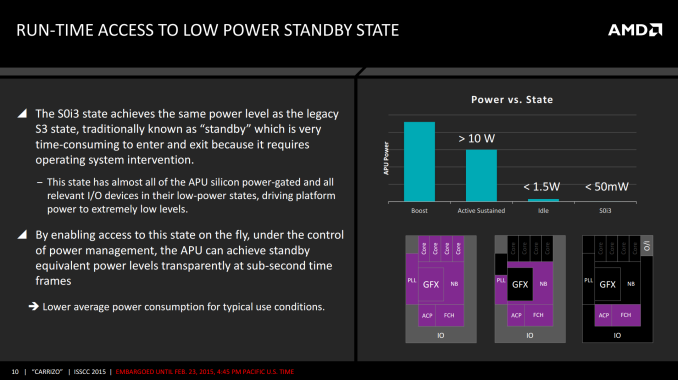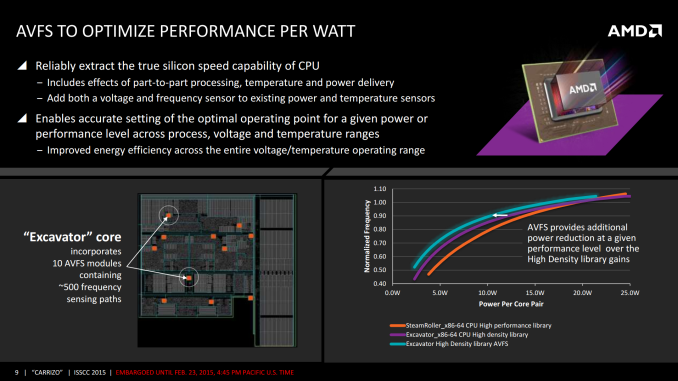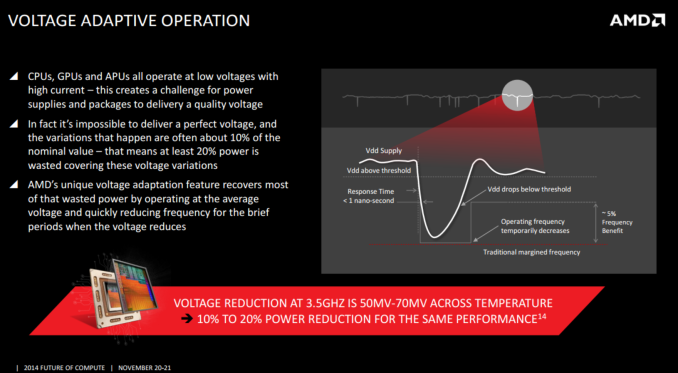AMD Launches Carrizo: The Laptop Leap of Efficiency and Architecture Updates
by Ian Cutress on June 2, 2015 9:00 PM ESTPower Saving and Power Consumption
When it comes to power, Carrizo features two/three technologies worth discussing. The first is the use of low power states, and the different frequency domains within the SoC. Previous designs had relatively few power planes, which left not as many chances for the SoC to power down areas not in use. Carrizo has ten power planes that can be controlled at run-time, allowing for what can be described as a dynamic race to sleep. This is bundled with access to the S0i3 power state, giving sub 50mW SoC power draw when in sleep and wake-up times under a second.
This is also combined with automated voltage/frequency sensors, of which an Excavator core has 10 each. These sensors take into consideration the instructions being processed, the temperature of the SoC, the quality of power delivery as well as the voltage and frequency at that point in order to relay information about how the system should adjust for the optimal power or performance point.
AMD states that this gives them the ability to adjust the frequency/power curve on a per-module basis further again to the right, providing another reduction in power or increase in frequency as required.
Next up for discussion is the voltage adaptive operation that was introduced back in Kaveri. I want to mention it here again because when it was first announced, I thought I understood it at a sufficient level in order to write about it. Well, having crossed another explanation of the feature by David Kanter, the reason for doing so clicked. I’m not going to steal his thunder, but I suggest you read his coverage to find out in more detail, but the concept is this:
When a processor does work, it draws power. The system has to be in a position to provide that power, and the system acts to restabilize the power while the processor is performing work. The work being done will cause the voltage across the processor to drop, to what we classically call Voltage Droop. As long as the droop does not cause the system to go below the minimum voltage required for operation, all is good. Voltage Droop works if the supply of power is consistent, although that cannot always be guaranteed – the CPU manufacturer does not have control over the quality of the motherboard, the power supply or the power conversion at hand. This causes a ripple in the quality of the power, and the CPU has to be able to cope with these ripples as these ripples, combined with a processor doing work, could cause the voltage to drop below the threshold.
The easiest way to cope is to put the voltage of the processor naturally higher, so it can withstand a bigger drop. This doesn’t work well in mobile, as more voltage results in a bigger power draw and a worse experience. There are other potential solutions which Kanter outlines in his piece.
AMD has tackled the problem is to get the processor to respond directly. When the voltage drops below a threshold value, the system will reduce the frequency and the voltage of the processor by around 5%, causing the work being done to slow down and not drain as much. At AMD’s Tech Day, they said this happens in as quickly as 3 cycles from detection, or in under a nanosecond. When the voltage drop is normalized (i.e. the power delivery is a more tolerable level), the frequency is cranked back up and work can continue at a normal rate.
Obviously the level of the threshold and the frequency drop will determine how much time is spent in this lower frequency state. We were told that with the settings used in Carrizo, the CPU hits this state less than 1% of the time, but it accounts for a sizeable chunk of overall average power reduction for a 3.5 GHz processor. This may sound odd, but it can make sense when you consider that the top 5% of the frequency is actually the most costly in terms of power than any other 5%. By removing that 5% extreme power draw, for a minimal performance loss (5% frequency loss for sub 1% of the time), it saves enough power to be worthwhile.













137 Comments
View All Comments
FlushedBubblyJock - Tuesday, June 9, 2015 - link
they probably have their contrast off, clear type disabled, the wrong screen font, smoothing edges of fonts disabled, then he's probably a far sighted coke bottled glasses with bifocals... thus amd must be had in dooper high rezz at 14fps...meacupla - Wednesday, June 3, 2015 - link
Ideally, what you'd get is a 2560x1440 screen with PROPER scaling to 1280x720, unlike what most monitors seem to do, which is a terrible job at scaling.SilthDraeth - Wednesday, June 3, 2015 - link
I run a Kaveri on my desktop and it drives 1080p just fine. Anyways, most intel laptops in that same range run 1366x768 screens also. At least almost every laptop you find in a Staples, or a Walmart. Very few of the devices on display have a higher resolution screen, or IPS solution.yankeeDDL - Wednesday, June 3, 2015 - link
Yes, *and* Intel's in that price range don't run games.FlushedBubblyJock - Tuesday, June 9, 2015 - link
yes they do make sure you have hd3000 at least but that's cheap as beansMargalus - Wednesday, June 3, 2015 - link
how is it an "issue that plagues AMD"? Are you saying AMD chips are buggy and crash at that resolution? Are you saying AMD graphics get corrupted at that resolution?medi03 - Thursday, June 4, 2015 - link
Ditto.In fact, 1366x768 TN (!!!) screen is the main issue with AMD mobile chips.
Drumsticks - Wednesday, June 3, 2015 - link
The 45W A8-6500T scores 71 in Cinebench R15. Even assuming that 15W kaveri gets identical performance (I couldn't think of a 15w kaveri chip to check on bench) that puts it at 106, which is finally, finally even with broad well in the xps 13, or at least <10%.Skylake will probably add another 10% gap, but this is the closest AMD might be in the last seven years or so to catching up with Intel. And at half the price, they could seriously have the start of a comeback!
xenol - Wednesday, June 3, 2015 - link
My only problem with AMD and the marketing blurbs is that they're targeting niche markets for all intents and purposes. Despite what PC gamers want us to think how big PC gaming is, it's not exactly a majority player in the entire scheme of things and gaming on a laptop isn't really that accepted.And even if gaming is involved, it's usually not games that require beefy specs to begin with.
Michael Bay - Wednesday, June 3, 2015 - link
PC gaming by marketshare is on par with any pastgen/nextgen console and sometimes more than one.